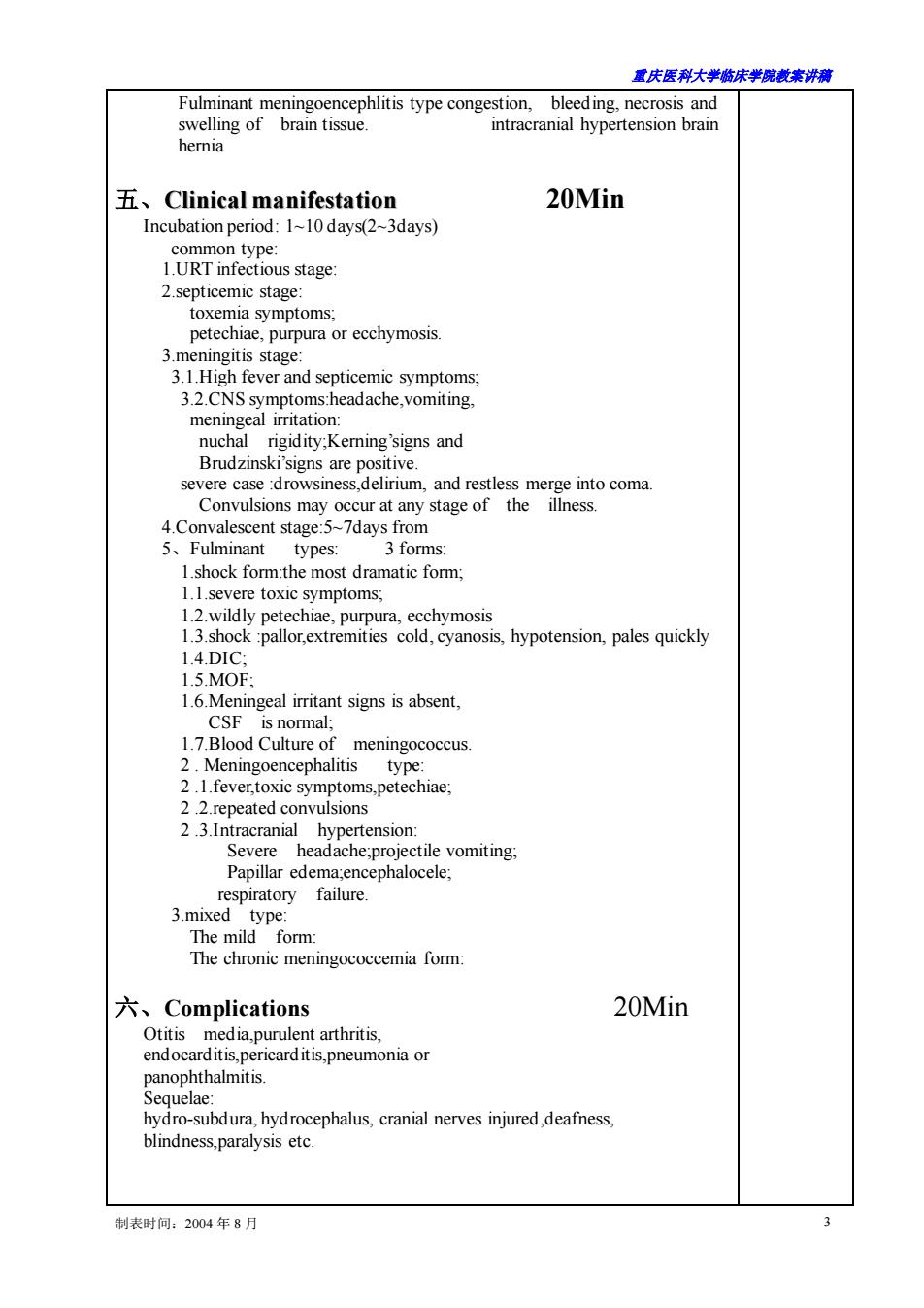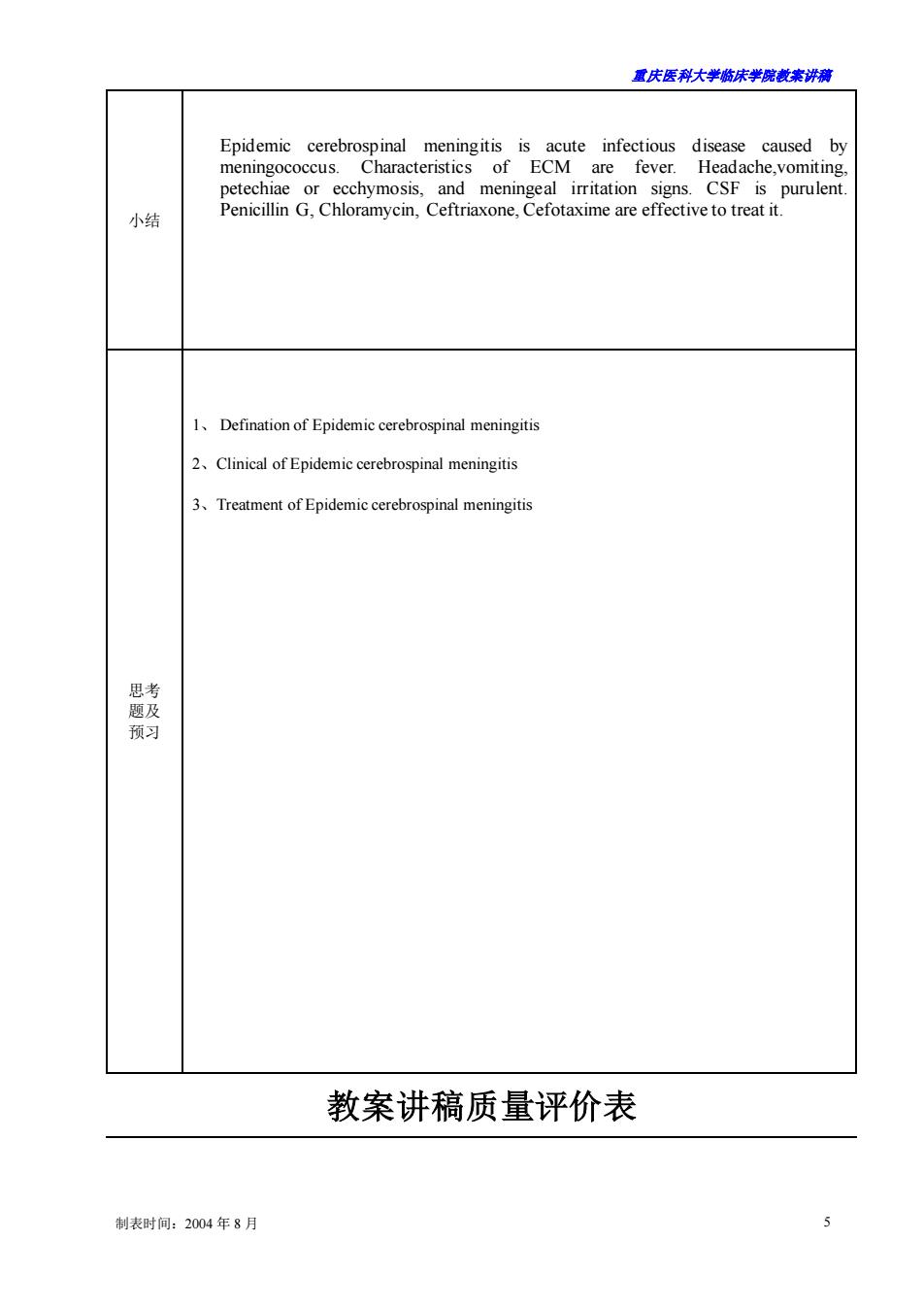
重庆医科大学脑床半院载未满 重庆医科大学临床学院教案及讲稿 课程名称传染病学年级2004级授课专业 留学生 数师袁喆职称副牧授授课方式 大课示教学时4 题目章节Part3 Chapter3 Epidemic cerebrospinal meningitis 教材名称Lemology 作者 Chief Editor:LiuZhengwen 出版社Xi'an Jiaotong University 版次2004.11 教 5.Clinical manifestation of Epidemic cerebrospinal meningitis 的 6.Complications Diagnosis 9.Treatment of Epidemic cerebrospinal meningitis Epidemic Process and The effect factor 难 2.of Epidemic cerebrospinal meningitis 点 Epidemic Proces and The effect Factors 重 3 Diagn 占 4.Treatment ofEpidemic cerebrospinal meningitis English Language 学 方法 Classroom lectures and multimedia 手 15th Edition Mandell,Douglas and Bennett's Principales and Practice of Infectious Diseasea Vol-2 2001 edited by Gerald L Mandell Jone e Bennett Raphael Dolin publishing by Harcourt Ansia and 资料 Churchill Livingstone. 2.4th Edition Kelley's Textbook of Internal Medicine 2004 edited by H.David Humes,publishing 见 教学组长: 教研室主任: 年 月 日 制表时间:2004年8月 1
重庆医科大学临床学院教案讲稿 制表时间:2004 年 8 月 1 重庆医科大学临床学院教案及讲稿 课程名称 传染病学 年级 2004 级 授课专业 留学生 教 师 袁 喆 职称 副教授 授课方式 √大课 示教 学时 4 题目章节 Part 3 Chapter3 Epidemic cerebrospinal meningitis 教材名称 Lemology 作者 Chief Editor :Liu Zhengwen 出 版 社 Xi’an Jiaotong University 版次 2004 .11 教 学 目 的 要 求 1. Definition 2. Etiology 3.Epidemiology 4. Pathogenesis 5. Clinical manifestation of Epidemic cerebrospinal meningitis 6. Complications 7. Laboratory Findings 8. Diagnosis and Differential Diagnosis 9.Treatment of Epidemic cerebrospinal meningitis 教 学 难 点 1.Epidemic Process and The effect Factors。 2.Pathogenesis of Epidemic cerebrospinal meningitis 教 学 重 点 1.Epidemic Process and The effect Factors 2.Features of Epidemic cerebrospinal meningitis 3.Diagnosis of Epidemic cerebrospinal meningitis 4.Treatment ofEpidemic cerebrospinal meningitis 外语 要求 English Language 教学 方法 手段 Classroom lectures and multimedia 参考 资料 1、15th Edition Mandell,Douglas and Bennett’s Principales and Practice of Infectious Diseasea.Vol-2, 2001 edited by Gerald L.Mandell,Jone E.Bennett,Raphael Dolin, publishing by Harcourt Ansia and Churchill Livingstone. 2、4th Edition Kelley’s Textbook of Internal Medicine 2004 edited by H.David Humes, publishing by Lippincott Williams & Wilkins Inc. 教研 室意 见 教学组长: 教研室主任: 年 月 日

置庆医科大半脑床半院藏未讲满 Time arrangement 、Definition 15Min 1. cerebrospinal meningitis is acute infectious disease caused by of ECM are fever, 3 Headache ecchymosis, and meningeal irritation signs. 二、Etiology 25Min 1.Pathogen is Neisseria meningitidis(meningococcus). G-diplococcus. orga se soy agar in 5~10%CO2,PH 7.4~7.6: nism i s. autolysin ctant 2 3 autolysis by 3.The ism can be detected in patient's nasopharynx,blood,CSF petechiae in skin 4.Pathogenic factor: endotoxin 5.Serogroups of meningoccus: 辅助手段: 13 serogroups and more than 20 serotypes found in the world; most common serogroups: A B C group Group A is the most common in china. 三、Epidemiology 20Min 时间分配 1Source of infection: 见教学内容 patients and carriers; 2.The routes of transmission 1)air borne 2)closed contact transmission 3.Susceptibility of population:universal susceptible stable and persistent immunity feature November-May April 四、Pathogenesis 20Min Septicemic tonbtengnehnoa ag 2.co swelling of meningeal vessel. tein neutrophil and plasma (CSF is purulent) 制表时间:2004年8月
重庆医科大学临床学院教案讲稿 制表时间:2004 年 8 月 2 Time arrangement 一、Definition 15Min 1. Epidemic cerebrospinal meningitis is acute infectious disease caused by meningococcus. 2. Characteristics of ECM are fever, 3. Headache, vomiting , petechiae or ecchymosis , and meningeal irritation signs. CSF is purulent . 二、Etiology 25Min 1.Pathogen is Neisseria meningitidis (meningococcus); G- diplococcus. 2.Biological features: 2.1.The organism grow by incubation on blood,chocolate or trypticase soy agar in 5~10%CO2,PH 7.4~7.6; 2.2.The organism is susceptible to dry, heat , chill and disinfectant; 2.3. autolysis by autolysin in vitro; 3.The organism can be detected in patient’s nasopharynx, blood, CSF, petechiae in skin; 4.Pathogenic factor: endotoxin. 5.Serogroups of meningoccus; 13 serogroups and more than 20 serotypes found in the world; most common serogroups: A B C group Group A is the most common in china. 三、Epidemiology 20Min 1.Source of infection: patients and carriers; 2.The routes of transmission : 1) air borne 2) closed contact transmission : 3.Susceptibility of population: universal susceptible stable and persistent immunity 4.Epidemiologic feature: (1). Season: November - May high peak: March - April (2).age: 6 months to 2 years old 四、Pathogenesis 20Min Septicemic stage: 1. vascular endothelial injury; 2. vascular wall inflammation,necrosis, 3. thrombosis, perivascular bleeding Meningitis stage: 1. Site: leptomeninx , arachnoid 2. congestion, bleeding, swelling of meningeal vessel, 3. Exudation of fibroprotein , neutrophil and plasma ( CSF is purulent) 4. cranial nerves is injured. 辅助手段: 同步播放 多媒体课件 时间分配: 见教学内容

量庆医科大学脑床半院藏素讲满 Fulminant meningoencephlitis type congestion,bleeding.necrosis and swelling of brain tissue. intracranial hype ertension brain hernia 五、Clinical manifestation 20Min Incubation period:1~10days(2-3days) RTomeTisHaee 2 septicemic stage toxemia svmptoms petechiae,purpura or ecchymosis. 3.meningitis stage: 3.1.High fever and septicemic symptoms, 3.2.CNS symptoms:headache,vomiting, meningeal irritation: rigidity,Kerning'signs and Bndatiswsacpeie sev 4.Cor ns may ur at a the shock form:t dra matic form; 1.4.DIC: 1.5.MOF 16 Meningeal irritant signs is absent CSF is normal; 1.7.Blood Culture of meningococcus. 2.Meningoencephalitis type: 2.1.fever,toxic symptoms,petechiae; 2.2.repeated convulsions 2.3.Intracranial The form The chronic meningococcemia form 六、Complications 20Min Otitis media purulent arthritis. endocarditis.pericarditis,pneumonia or panophthalmitis. Sequelae: hydro-subdura,hydrocephalus,cranial nerves injured,deafness, blindness,paralysis etc. 制表时间.2004年8月
重庆医科大学临床学院教案讲稿 制表时间:2004 年 8 月 3 Fulminant meningoencephlitis type congestion, bleeding, necrosis and swelling of brain tissue. intracranial hypertension brain hernia 五、Clinical manifestation 20Min Incubation period: 1~10 days(2~3days) common type: 1.URT infectious stage: 2.septicemic stage: toxemia symptoms; petechiae, purpura or ecchymosis. 3.meningitis stage: 3.1.High fever and septicemic symptoms; 3.2.CNS symptoms:headache,vomiting, meningeal irritation: nuchal rigidity;Kerning’signs and Brudzinski’signs are positive. severe case :drowsiness,delirium, and restless merge into coma. Convulsions may occur at any stage of the illness. 4.Convalescent stage:5~7days from 5、Fulminant types: 3 forms: 1.shock form:the most dramatic form; 1.1.severe toxic symptoms; 1.2.wildly petechiae, purpura, ecchymosis 1.3.shock :pallor,extremities cold, cyanosis, hypotension, pales quickly 1.4.DIC; 1.5.MOF; 1.6.Meningeal irritant signs is absent, CSF is normal; 1.7.Blood Culture of meningococcus. 2 . Meningoencephalitis type: 2 .1.fever,toxic symptoms,petechiae; 2 .2.repeated convulsions 2 .3.Intracranial hypertension: Severe headache;projectile vomiting; Papillar edema;encephalocele; respiratory failure. 3.mixed type: The mild form: The chronic meningococcemia form: 六、Complications 20Min Otitis media,purulent arthritis, endocarditis,pericarditis,pneumonia or panophthalmitis. Sequelae: hydro-subdura, hydrocephalus, cranial nerves injured,deafness, blindness,paralysis etc

重庆医科大学脑床半院载未讲满 七、Laboratory Findings 20Min 1.Epidemiologic data: 2.Clinical manifestations: 3.Lab findings; 1.Blood pictures:WBC20x109,PLT is decrease in DIC: 2.CSF is suppurative. 3.Bacteriologic diagnosis:smear or culture; 4.Immunologic test:antigen and antibody 八、Diagnosisand Differential Diagnosis 10M MENINGITS 1 Other 5oa。erep. 九、Treatment 10Min COMMON TYPE: 1.General treatment: 2Pathogenic treatment ramycin pathoo nic therapy, 2Anti-shock; 3.Steroid;hydrocoticosterone etc: 4.Anti-DIC: 5.Protect major organs; 制表时间:2004年8月
重庆医科大学临床学院教案讲稿 制表时间:2004 年 8 月 4 七、Laboratory Findings 20Min 1.Epidemiologic data: 2 .Clinical manifestations: 3 .Lab findings; 1.Blood pictures: WBC20x109,PLT is decrease in DIC; 2.CSF is suppurative; 3.Bacteriologic diagnosis:smear or culture; 4.Immunologic test:antigen and antibody 八、Diagnosis and Differential Diagnosis 10Min 1.Other purulent meningitis; 2 .TB MENINGITIS; 3.Epidemic encephalitis B; 4.Septicemia. 九、Treatment 10Min COMMON TYPE: 1.General treatment: 2 .Pathogenic treatment : 2 .1.penicillin G: 2 .2 .Chloramycin: 2 .3.Ceftriaxone,Cefotaxime; 3.symptomatic therapy: SHOCK form: 1.pathogenic therapy; 2 .Anti-shock; 3. Steroid;hydrocoticosterone etc; 4. Anti-DIC; 5. Protect major organs;

君庆医科大学脑床半院表来讲测 Epidemic cerebrospinal meningitis is acute infectious disease caused by meningococcus.Characteristics of ECM are fever.Headache,vomiting. petechiae or ecchymosis,and meningeal irritation signs.CSF is purulent. 小结 Penicillin G,Chloramycin,Ceftriaxone,Cefotaxime are effective to treat it. 1.Defination of Epidemic cerebrospinal meningitis 2.Clinical of Epidemic cerebrospinal meningitis 3Treatment of Epidemic cerebrospinal meningitis 教案讲稿质量评价表 制表时间:2004年8月
重庆医科大学临床学院教案讲稿 制表时间:2004 年 8 月 5 小结 Epidemic cerebrospinal meningitis is acute infectious disease caused by meningococcus. Characteristics of ECM are fever. Headache,vomiting, petechiae or ecchymosis, and meningeal irritation signs. CSF is purulent. Penicillin G, Chloramycin, Ceftriaxone, Cefotaxime are effective to treat it. 思考 题及 预习 1、 Defination of Epidemic cerebrospinal meningitis 2、Clinical of Epidemic cerebrospinal meningitis 3、Treatment of Epidemic cerebrospinal meningitis 教案讲稿质量评价表